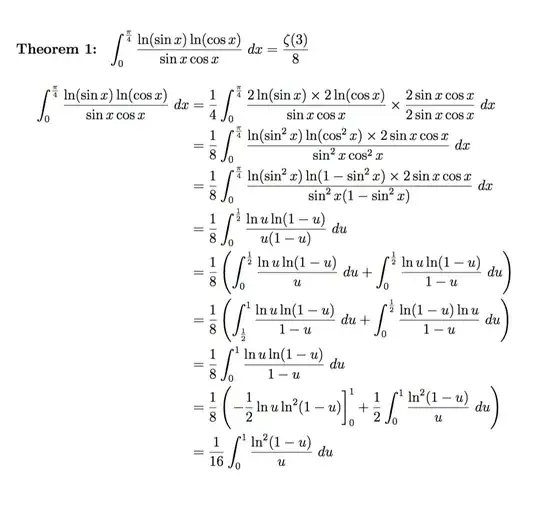Here is an approach that makes use of an Euler sum.
We will first find a Maclaurin series expansion for $\ln^2 (1 - x)$. As
$$\ln (1 - x) = - \sum_{n = 1}^\infty \frac{x^n}{n},$$
we have
\begin{align*}
\ln^2 (1 - x) &= \left (- \sum_{n = 1}^\infty \frac{x^n}{n} \right ) \cdot \left (- \sum_{n = 1}^\infty \frac{x^n}{n} \right ).
\end{align*}
Shifting the summation index $n \mapsto n + 1$ gives
\begin{align*}
\ln^2 (1 - x) &= x^2 \left (- \sum_{n = 0}^\infty \frac{x^n}{n + 1} \right ) \cdot \left (- \sum_{n = 0}^\infty \frac{x^n}{n + 1} \right )\\
&= \sum_{n = 0}^\infty \sum_{k = 0}^n \frac{x^{n + 2}}{(k + 1)(n - k + 1)},
\end{align*}
where the last line has been obtained by applying the Cauchy product.
Shifting the summation indices as follows: $n \mapsto n - 2, k \mapsto k - 1$ gives
\begin{align*}
\ln^2 (1 - x) &= \sum_{n = 2}^\infty \sum_{k = 1}^{n - 1} \frac{x^n}{k(n - k)}\\
&= \sum_{n = 2}^\infty \sum_{k = 1}^{n - 1} \left (\frac{1}{nk} + \frac{1}{n(n - k)} \right ) x^n\\
&= 2 \sum_{n = 2}^\infty \frac{x^n}{n} \sum_{k = 1}^{n - 1} \frac{1}{k}\\
&= 2 \sum_{n = 2}^\infty \frac{H_{n - 1} x^n}{n},
\end{align*}
where $H_n$ is the $n$th harmonic number.
Now evaluating the integral. From the above Maclaurin series expansion for $\ln^2 (1 - x)$ the integral can be written as
\begin{align*}
\int_0^1 \frac{\ln^2 (1 - x)}{x} \, dx &= 2 \sum_{n = 2}^\infty \frac{H_{n - 1}}{n} \int_0^1 x^{n - 1} \, dx = 2 \sum_{n = 2}^\infty \frac{H_{n - 1}}{n^2}.
\end{align*}
From properties of the harmonic numbers we have
$$H_n = H_{n - 1} + \frac{1}{n},$$
thus
\begin{align*}
\int_0^1 \frac{\ln^2 (1 - x)}{x} \, dx &= 2 \sum_{n = 2}^\infty \frac{H_n}{n^2} - 2 \sum_{n = 2}^\infty \frac{1}{n^3} = 2 \sum_{n = 1}^\infty \frac{H_n}{n^2} - 2 \sum_{n = 1}^\infty \frac{1}{n^3}.
\end{align*}
Each sum can be readily found. They are:
$$\sum_{n = 1}^\infty \frac{1}{n^3} = \zeta (3) \quad \text{and} \quad \sum_{n = 1}^\infty \frac{H_n}{n^2} = 2 \zeta (3).$$
A proof of the result for the second sum containing the harmonic number can, for example, be found here. Thus
$$\int_0^1 \frac{\ln^2 (1 - x)}{x} \, dx = 4 \zeta (3) - 2 \zeta (3) = 2 \zeta (3),$$
as required.
